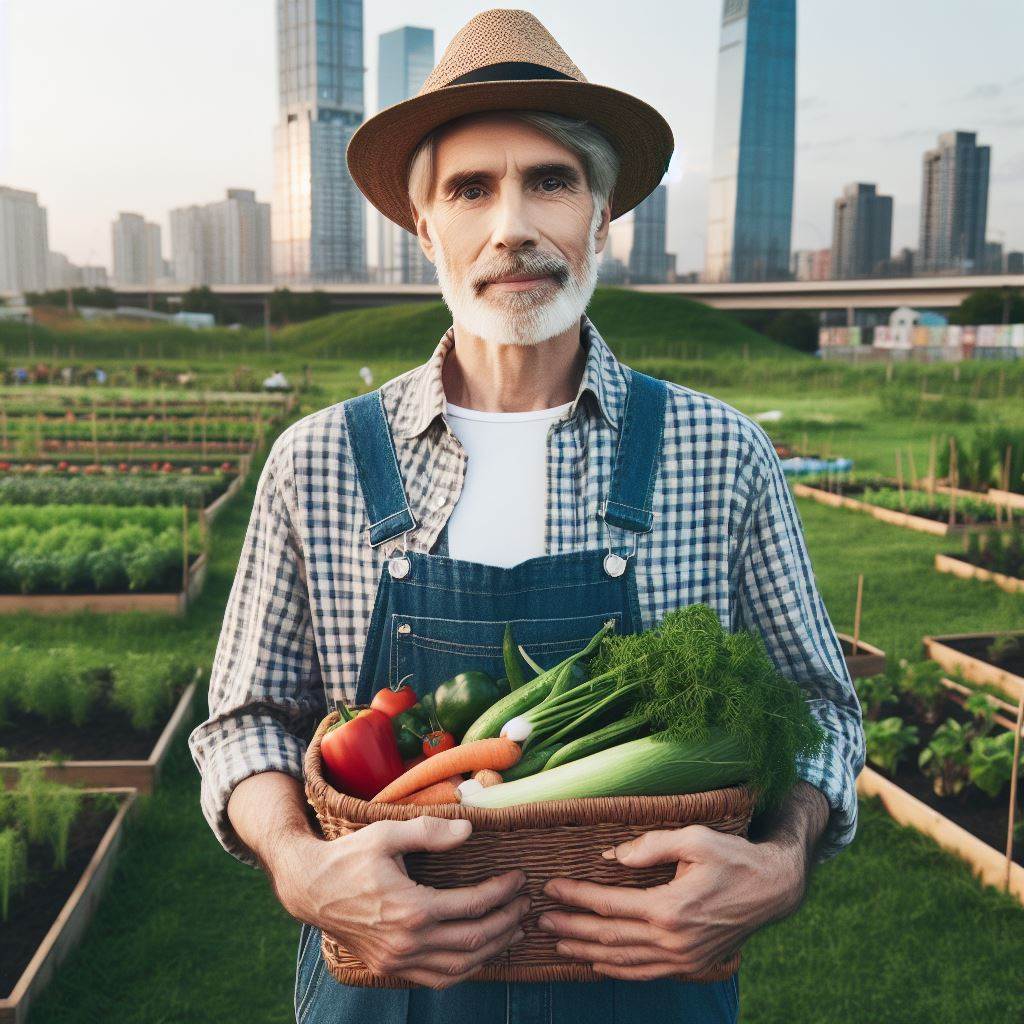Introduction
Urban farming has gained significant importance due to the growing concern for global food security.
With the rapid urbanization and shrinking agricultural lands, the need for alternative ways of producing food has become paramount.
Urban farming refers to the practice of growing, harvesting, and distributing food within urban areas.
It encompasses a range of techniques such as rooftop gardens, vertical farming, community gardens, and hydroponics.
The purpose of this blog post is to introduce beginners to the basics of urban farming, equipping them with knowledge and tools to start their own urban farming projects.
By delving into important topics such as plant selection, soil preparation, and pest management, readers will gain a comprehensive understanding of the urban farming process.
Through this blog post, readers will become familiar with the benefits of urban farming, including improved access to fresh produce, reduced food transportation costs, and the promotion of sustainable living practices.
Furthermore, it will emphasize the importance of community engagement and collaboration in creating successful urban farming initiatives.
By exploring the fundamental aspects of urban farming, this blog post aims to inspire individuals to tap into the potential of urban spaces for agricultural purposes.
Whether one is a city dweller with limited space or a community organizer seeking to transform vacant lots into productive gardens, this section will serve as a valuable resource to kick-start their urban farming journey.
Benefits of Urban Farming
Urban farming provides a wide range of benefits, including social, environmental, and economic advantages.
Let’s explore each of these benefits in detail.
Social benefits
- Community engagement: Urban farming encourages individuals and communities to come together, fostering social connections and a sense of belonging. By working collectively on garden projects, people can build relationships, share knowledge, and support each other.
- Increasing access to fresh and healthy food: Many urban areas lack access to fresh, locally grown produce. Urban farming addresses this issue by bringing food production closer to communities. By growing fruits, vegetables, and herbs in neighborhood gardens, urban farmers provide affordable and nutritious food options for their communities.
Environmental benefits
- Reducing food miles and carbon footprint: Traditional food systems involve long transportation distances, resulting in increased greenhouse gas emissions. Urban farming shortens the distance between the farm and the consumer, reducing the carbon footprint associated with food production and distribution. This sustainable approach helps mitigate climate change.
- Enhancing biodiversity: Urban farming can transform vacant lots and rooftops into green spaces filled with diverse plant life. This not only improves the aesthetics of the city but also creates habitats for various pollinators, birds, and beneficial insects. By supporting biodiversity, urban farming contributes to a healthier ecosystem.
Economic benefits
- Cost savings on grocery bills: Growing food in urban areas allows individuals and families to save money on their grocery bills. By producing their own fruits and vegetables, urban farmers reduce their reliance on expensive store-bought produce. This can have a significant positive impact on household budgets.
- Potential for selling surplus: Urban farmers often yield more produce than they can consume themselves. This surplus can be sold at local markets, offering an additional source of income. Selling homegrown crops not only supports the local economy but also encourages entrepreneurial opportunities and self-sufficiency.
In short, urban farming offers numerous benefits to individuals, communities, and the environment.
It promotes community engagement, provides access to fresh and healthy food, reduces carbon footprint, enhances biodiversity, generates cost savings, and creates economic opportunities.
By embracing urban farming, we can build sustainable and resilient cities while enjoying the many advantages it offers.
Transform Your Agribusiness
Unlock your farm's potential with expert advice tailored to your needs. Get actionable steps that drive real results.
Get StartedRead: Permaculture for Climate Change Adaptation
Getting Started with Urban Farming
Assessing available space
When embarking on your urban farming journey, the first step is to assess the available space you have.
Depending on the type of space you have access to, you can explore different options for urban farming.
- Balconies or rooftop gardens: Utilize these spaces to create your urban farm. Whether you have a small balcony or a spacious rooftop, you can grow a variety of crops in containers or raised beds.
- Indoor gardening options: If you lack outdoor space, consider indoor gardening. Utilize windowsills, vertical gardening systems, or hydroponics to grow herbs, vegetables, or even small fruiting plants inside your home.
Determining sunlight and soil conditions
Adequate sunlight and suitable soil conditions are vital for the success of your urban farming endeavors.
Before starting your farm, assess the sunlight and soil quality in your chosen space.
- Importance of adequate sunlight: Most crops require at least 6 hours of direct sunlight daily. Observe the amount of sunlight your space receives to ensure it is suitable for growing plants.
- Testing soil quality: Conduct a soil test to determine its composition and fertility. This will help you understand if any amendments, such as compost or organic fertilizers, are necessary.
Choosing suitable crops
Choosing the right crops is essential for a successful urban farm. Consider the specific conditions of your space when selecting plants.
- Researching suitable plants for the urban environment: Look for crops that thrive in the urban setting. Consider factors like limited space, pollution, and noise when making your selections.
- Factors to consider when selecting crops: Take into account the available space, seasonality of the plants, and your personal preferences. Opt for crops that you enjoy eating and are well-suited for your specific space.
By following these steps, you can get started with urban farming and enjoy the benefits of growing your own fresh produce in a limited space.
Assess your available space, consider sunlight and soil conditions, and choose the right crops. Happy farming!
Read: Edible Forest Gardens: Permaculture Gem
Essential Tools and Supplies
Having the right tools and supplies is vital for successful urban farming.
Whether you have a small balcony garden or a larger rooftop space, the following essentials will help you get started.
Basic gardening tools
Gardening tools are essential for maintaining and cultivating your urban farm. Here are three must-have tools:
Hand Trowel
A hand trowel is a small gardening tool with a pointed scoop, perfect for digging small holes, transplanting seedlings, and removing weeds.
Pruning Shears
Pruning shears are useful for trimming and shaping plants, removing dead or damaged branches, and harvesting fruits or vegetables.
Watering Can or Garden Hose
Keeping your plants hydrated is crucial for their growth. Choose a watering can or a garden hose depending on the size of your urban farm.
Containers or raised beds
Since urban farming often takes place in limited spaces, containers and raised beds are popular choices for growing plants.
Consider the following options:
Different Container Options
You can use various containers such as pots, planters, or even repurposed items like buckets or barrels. Ensure they have drainage holes.
Benefits of Raised Beds
Raised beds offer many advantages, including better soil drainage, easy access for maintenance, and the ability to grow a wide range of plants.
Soil and compost
High-quality soil and compost are critical for the success of your urban farm. Pay attention to the following factors:
Importance of Quality Soil
Choose a well-balanced soil mix that provides adequate drainage, retains moisture, and is rich in nutrients. Consider adding organic matter for healthier plants.
Composting Basics
Compost is a valuable addition to your urban farm. Start composting kitchen scraps, yard waste, and other organic materials to create nutrient-rich compost for your plants.
By having the right tools, containers, and nutrient-rich soil, your urban farm will thrive and yield bountiful harvests.
Read: Sustainable Irrigation Techniques Guide
Showcase Your Farming Business
Publish your professional farming services profile on our blog for a one-time fee of $200 and reach a dedicated audience of farmers and agribusiness owners.
Publish Your ProfileWatering and Irrigation Techniques
Proper watering and irrigation techniques are essential for the success of urban farming. Water is a vital resource that plants need to grow and thrive.
This section will discuss the importance of proper watering and different techniques that can be used.
Importance of proper watering
Preventing overwatering and underwatering
Overwatering can suffocate the roots and lead to root rot, while underwatering can stunt plant growth and result in wilting. It is crucial to find the right balance.
Understanding plant water requirements
Different plants have varying water needs. Understanding the specific requirements of each plant can help prevent water-related issues and optimize growth.
Watering techniques
Hand watering
Hand watering is a traditional and straightforward method of delivering water to plants. It involves using a watering can or hose to directly water the base of the plants.
Drip irrigation systems
Drip irrigation is a more efficient and automated way of watering plants.
It involves using a network of tubes with small holes or emitters that deliver water directly to the plants’ root zones.
Hand watering is suitable for smaller-scale urban gardens, where the plants can be easily reached.
It allows for precise control over the amount of water given to each plant.
When hand watering, it is important to water deeply, ensuring that the water penetrates the soil and reaches the plants’ root systems.
Drip irrigation systems are ideal for larger-scale urban farming projects. They provide a consistent and controlled water supply, saving time and reducing water wastage.
Drip systems can be set up with timers and sensors, ensuring that plants receive water at the optimal times and in the right quantities.
When using drip irrigation, it is essential to adjust the flow rate and frequency based on the specific water requirements of the plants being grown.
Additionally, regular maintenance and inspection of the system are necessary to prevent clogs and ensure efficient water distribution.
In fact, proper watering and irrigation techniques are crucial for successful urban farming.
Understanding the importance of preventing overwatering and underwatering, as well as knowing the water requirements of different plants, can help ensure their optimal growth.
Hand watering and drip irrigation are effective techniques that can be used depending on the scale and requirements of the urban farming project.
Read: Polycultures vs Monocultures in Farming
Planting and Maintenance
Starting from seeds vs. seedlings
Pros and cons of each
Starting from seeds allows for a wider variety of plant options, but it requires more time and effort. Seedlings provide a head start and save time, but the options are limited.
Tips for successful seed starting
Ensure proper moisture levels, provide adequate light, maintain temperature, and follow seed packet instructions for optimal germination.
Planting and transplanting
Proper planting depth and spacing
Refer to plant-specific guidelines to determine the appropriate planting depth and spacing, which contribute to healthy root development and sufficient access to nutrients.
Transitioning seedlings to the outdoor environment
Gradually introduce seedlings to outdoor conditions by placing them in a sheltered area with increasing exposure to sunlight and fluctuating temperatures over a period of one to two weeks.
Maintenance practices
Fertilizing
Use organic fertilizers or compost to feed plants with essential nutrients, following the recommended dosage instructions. Avoid over-fertilization, as it can harm the plants.
Pruning and harvesting
Regularly prune plants to remove dead or diseased parts and promote better air circulation. Harvest crops when they reach maturity to ensure optimum flavor and quality.

Troubleshooting Common Issues
Pests and diseases
Urban farming, like any type of agriculture, is not immune to pests and diseases.
These factors can negatively impact your plants and reduce your yields. It is essential to be able to identify common pests and diseases in order to take appropriate action.
Identifying common pests and diseases in urban farming
Some common pests found in urban farming include aphids, caterpillars, and whiteflies.
These pests can damage the leaves and fruits of your plants, hindering their growth and productivity.
Additionally, diseases such as powdery mildew and blight can affect a wide range of crops in urban environments.
Utilizing organic pest control methods to protect your plants
Instead of relying on harmful chemical pesticides, consider implementing organic pest control methods.
These methods include companion planting, which involves cultivating plants that naturally repel pests, and introducing beneficial insects like ladybugs and lacewings to your garden.
Additionally, you can use organic sprays made from ingredients such as neem oil or garlic to deter pests.
Nutrient deficiencies
Inadequate nutrient levels can also pose a significant challenge in urban farming.
Poor soil quality or imbalanced fertilization can lead to nutrient deficiencies, which can stunt plant growth and result in reduced yields.
Recognizing signs of nutrient deficiencies in plants
Plants suffering from nutrient deficiencies exhibit various visual cues.
For example, a lack of nitrogen often manifests as yellowing leaves, while insufficient phosphorus can cause purpling or reddening of foliage.
Similarly, potassium deficiency can result in yellowing leaf margins and weak stems.
Familiarizing yourself with these signs is crucial for timely intervention to prevent further damage.
Addressing nutrient imbalances through appropriate fertilization techniques
To address nutrient imbalances, it is crucial to understand your soil’s nutrient needs.
Conduct a soil test to determine the deficiencies, and then choose appropriate fertilizers to supplement the lacking nutrients.
Showcase Your Farming Business
Publish your professional farming services profile on our blog for a one-time fee of $200 and reach a dedicated audience of farmers and agribusiness owners.
Publish Your ProfileOrganic options like compost, manure, and bone meal can be used to maintain a healthy nutrient balance in your soil.
Additionally, foliar spraying with nutrient-rich solutions can provide a quick boost to plants.
By proactively addressing common issues such as pests, diseases, and nutrient deficiencies, you can ensure the success of your urban farming endeavors.
Regular monitoring, proper identification, and timely interventions are key to maintaining healthy and productive crops.
Harvesting and Enjoying the Fruits of Your Labor
Harvesting and enjoying the fruits of your labor is a reward for all the hard work put into urban farming.
The satisfaction of seeing your crops grow from seeds to mature plants is immeasurable.
Here are some guidelines and tips on how to properly harvest, store, and preserve your fresh produce.
Harvesting guidelines
Knowing when to harvest
Harvesting at the right time ensures that your crops reach their peak flavor, texture, and nutritional value. Different vegetables and fruits have specific indicators of ripeness:
- Tomatoes: Firm and brightly colored fruits that easily detach from the vine.
- Lettuce: Harvest when outer leaves are large enough to use or when the center forms a loose head.
- Carrots: Mature roots are bright orange, smooth, and approximately 1 inch in diameter.
- Strawberries: Ripe berries are fully red, glossy, and easily detach from the stem.
Harvesting techniques for different crops
- Leafy greens: Pick outer leaves first, leaving the center intact for continuous growth.
- Root vegetables: Gently dig around the base and pull up the entire plant, taking care not to damage the roots.
- Herbs: Cut stems just above a node, which encourages new growth and enhances flavor.
- Fruiting plants: Use a sharp knife or scissors to cut the stem, leaving a small portion attached to the fruit.
Storage and preservation tips
Proper storage conditions
Storing your harvested crops in the right conditions extends their shelf life and maintains their quality:
- Leafy greens: Wash, dry, and store in sealed bags or containers with a paper towel to absorb moisture.
- Root vegetables: Remove greens, place in a cool, dark, and well-ventilated area with low humidity.
- Fruits: Keep them at room temperature until they reach optimal ripeness, then refrigerate.
Preserving excess produce
To avoid waste and make the most of your bountiful harvest, consider different preservation methods:
- Freezing: Blanch vegetables to retain their texture and color, then store in airtight containers or freezer bags.
- Canning: Preserve fruits and vegetables by canning them in jars with a hot water bath or pressure canner.
- Pickling: Create flavorful pickles by combining vegetables, vinegar, spices, and storing them in sterilized jars.
- Drying: Dehydrate fruits, herbs, and vegetables using an oven, dehydrator, or air-drying techniques.
- Fermenting: Transform vegetables into tangy sauerkraut or kimchi by fermenting them in a saltwater brine.
By following these harvesting, storage, and preservation tips, you can enjoy the fruits of your labor throughout the year.
From freshly picked salads to homemade pickles, urban farming allows you to savor the flavors of your own harvest while reducing your carbon footprint.
Community Resources for Urban Farmers
Local gardening organizations and clubs
- Connect with local gardening organizations to gain knowledge and support from experienced urban farmers.
- Attend club meetings and workshops to learn about new techniques and best practices for urban farming.
- Seek advice from seasoned urban farmers who can provide valuable insights and guidance.
- Collaborate with fellow farmers to exchange ideas, resources, and even crops for a diverse urban farming experience.
- Engage in community activities organized by these organizations to promote sustainable urban farming practices.
Community gardens and shared spaces
- Join community gardens as a way to access shared spaces and resources for urban farming.
- Network with other gardeners to learn from their experiences and share your own insights.
- Exchange surplus produce with other gardeners for a diverse and abundant urban farming community.
- Participate in community garden events and workshops to enhance your gardening skills and meet like-minded individuals.
- Abide by the rules and regulations set by the community gardens to maintain a harmonious and efficient urban farming space.
Online resources and forums
- Explore online resources and websites dedicated to urban farming for valuable information and tips
- Join online forums and discussions to connect with urban farmers around the world and exchange knowledge.
- Seek guidance from expert urban farmers through online platforms, such as webinars and Q&A sessions.
- Utilize online resources to learn about innovative technologies and practices that can enhance your urban farming techniques.
- Stay updated on the latest trends and research in urban farming through online publications and blogs.
By utilizing these community resources, urban farmers can expand their knowledge, receive support, and engage in collaborative efforts to build a thriving urban farming community.
Local gardening organizations and clubs
The presence of local gardening organizations and clubs provides a platform for urban farmers to connect with experienced individuals who can share their expertise and provide valuable guidance.
Attending club meetings and workshops allows farmers to learn about new techniques, best practices, and sustainable farming methods.
Community gardens and shared spaces
Community gardens and shared spaces play a vital role in urban farming by providing accessible land and resources.
Joining and actively participating in community gardens fosters a sense of belonging and encourages collaboration among fellow farmers.
Sharing surplus produce not only ensures a diverse diet but also strengthens the bonds within the community.
Online resources and forums
Online resources and forums further enhance the knowledge and support available to urban farmers.
Dedicated websites and blogs offer a wealth of information on various aspects of urban farming, such as crop selection, pest management, and soil health.
Engaging in online discussions with fellow farmers from different regions allows for the exchange of ideas and experiences.
Furthermore, online platforms provide opportunities to connect with expert urban farmers through webinars and virtual Q&A sessions.
This access to expert advice can be invaluable for beginners and experienced farmers alike.
Staying up to date with the latest research and trends in urban farming is made possible through online publications and blogs dedicated to the subject.
In a nutshell, community resources are essential for urban farmers to thrive.
By connecting with local gardening organizations and clubs, participating in community gardens, and utilizing online resources, farmers can expand their knowledge, receive support, and contribute to the growth of a vibrant urban farming community.
Conclusion
In this blog post some of the key points discussed include:
- Urban farming is a sustainable solution for growing food in urban areas.
- Choosing the right location and understanding local regulations are essential.
- Start with simple crops and gradually expand your urban farm.
- Adopt organic farming practices and focus on soil health for better yields.
- Utilize vertical gardening techniques to maximize space in small urban settings.
- Implement efficient watering systems and regularly monitor plant health.
- Connect with the local community and participate in farmers markets to sell your produce.
- Continue learning and stay updated with the latest urban farming trends and techniques.
Embarking on your urban farming journey may seem overwhelming, but remember that every great farmer started from scratch.
Don’t be afraid to make mistakes; they are valuable learning opportunities. Embrace the challenges and enjoy the rewards of growing your own food.
Your dedication to urban farming will not only benefit your health and the environment but also inspire others to adopt a more sustainable lifestyle.
Stay passionate, connect with fellow urban farmers, and don’t hesitate to seek guidance from experienced growers. Together, we can create a greener and healthier urban environment through urban farming!




